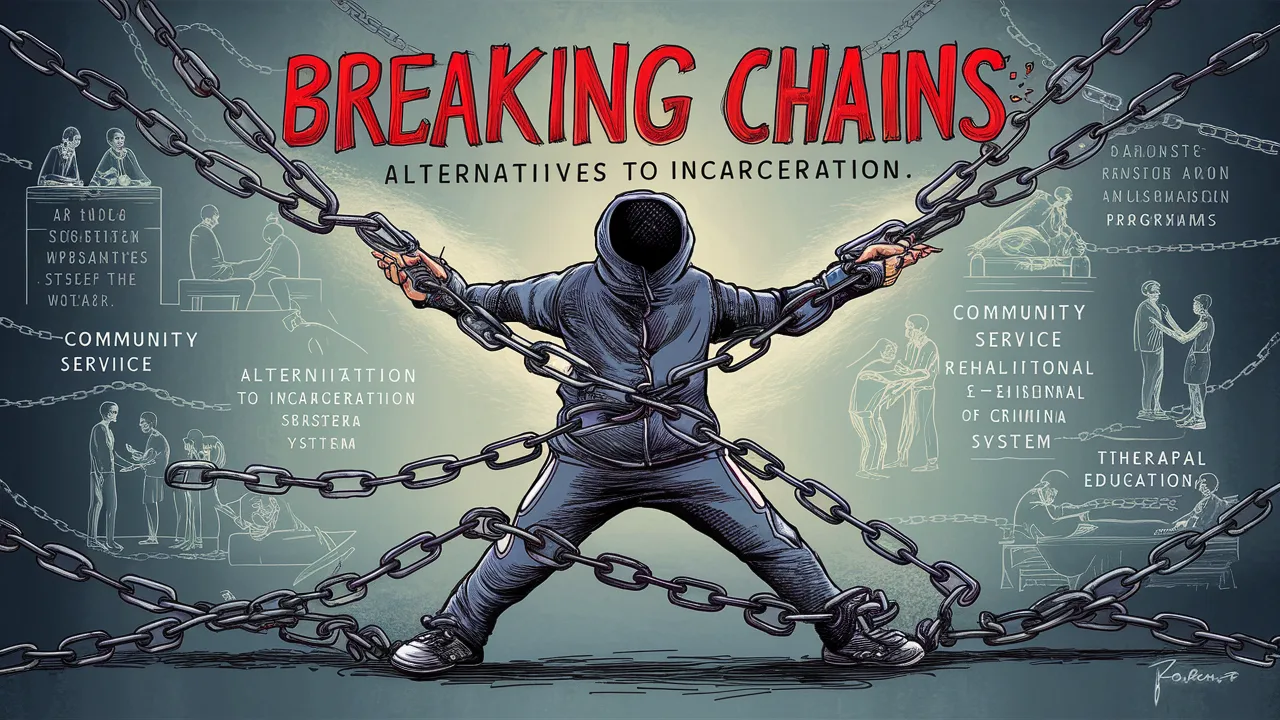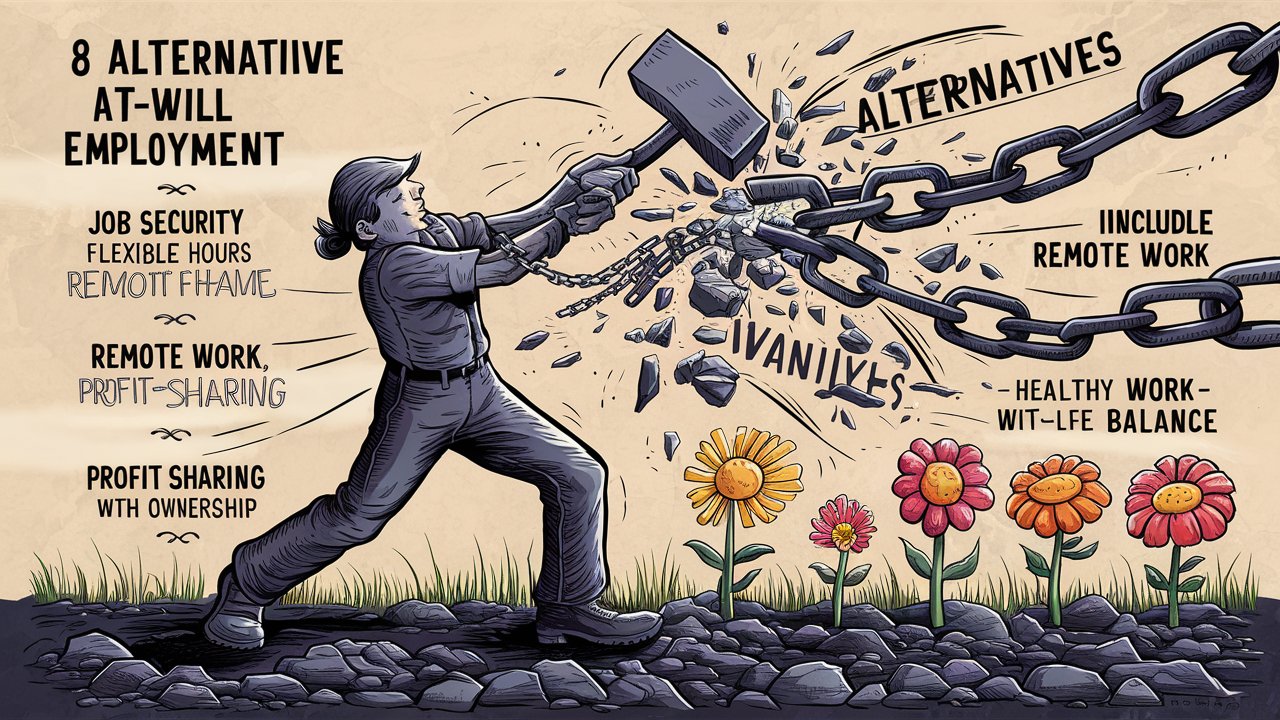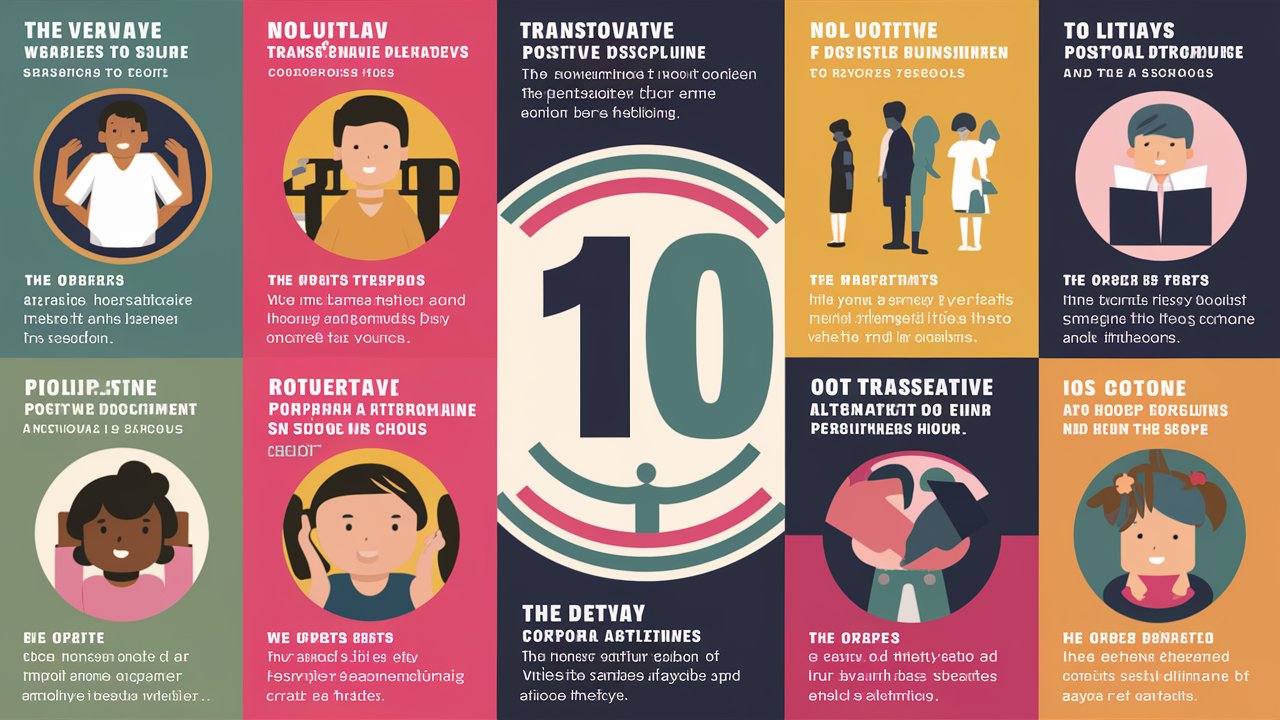Here is a table of 15 alternatives to incarceration, along with their pros and cons:
| Alternative | Pros | Cons |
|---|---|---|
| Probation | – Allows offender to remain in community |
– Less costly than incarceration- Requires close supervision to be effective.
– Offender may violate probation conditions.
| Parole | – Gradual reintegration into community |
– Provides support and monitoring- Offender may violate parole conditions
– Requires careful risk assessment
| House Arrest/Electronic Monitoring | – Allows offender to maintain employment and family ties |
– Less costly than incarceration- Requires constant monitoring
– Offender may tamper with device
| Day Reporting Centers | – Provides structure and supervision during the day |
– Connects offenders to services and programs- Requires reliable transportation for offenders
– Funding may be limited
| Community Service | – Allows offender to give back to the community |
– Less costly than incarceration- Requires close monitoring to ensure completion
– May not address underlying issues
| Restorative Justice | – Focuses on victim healing and offender accountability |
– Can reduce recidivism- Requires victim participation, which may be difficult
– May not be appropriate for all offenses
| Drug Courts | – Provides treatment and supervision for substance abuse offenders |
– Can reduce recidivism- Requires significant resources and coordination
– May not be available in all jurisdictions
| Mental Health Courts | – Connects offenders with mental health services |
– Can reduce recidivism- Requires specialized training and resources
– May not be available in all jurisdictions
| Diversion Programs | – Allows offenders to avoid a criminal record |
– Can address underlying issues- Eligibility may be limited to certain offenses
– Requires coordination with the justice system
| Fines | – Less costly than incarceration |
– Can be used for restitution- May not be effective for low-income offenders
– Does not address underlying issues
| Restitution | – Holds offenders accountable and provides compensation to victims |
– Can be combined with other alternatives- May be difficult to enforce and collect
– Does not address underlying issues
| Victim-Offender Dialogues | – Promotes healing and accountability |
– Can reduce recidivism- Requires victim willingness to participate
– May not be appropriate for all offenses
| Intensive Supervision Probation | – Provides more structure and support than traditional probation |
– Can address underlying issues- Requires significant resources and staffing
– May not be effective for high-risk offenders
| Halfway Houses | – Provides a structured transition back into the community |
– Connects offenders with services and support- May be limited availability or capacity
– Requires careful risk assessment
| Therapeutic Communities | – Provides long-term, residential treatment for substance abuse |
– Can address underlying issues- Requires significant time and resources
– May not be appropriate for all offenders Alternatives to Incarceration.
In a world where conventional methods of dealing with criminal behavior often lead to cycles of incarceration, it’s time to explore fresh perspectives and innovative solutions.
The current landscape of the criminal justice system highlights the pressing need for change, urging us to break free from the chains of traditional incarceration practices.
Criminal justice reform advocates, policymakers, social workers, and community activists stand at the frontline of this revolution, driving towards a more empathetic and effective approach.
Imagine a realm where alternatives to incarceration pave the way for rehabilitation, restoration, and redemption. This enlightening journey delves into seven eye-opening alternatives that not only challenge the status quo but also empower individuals to envision a future beyond bars.
From community-based programs fostering rehabilitation to restorative justice practices emphasizing healing over punishment, each alternative presents a beacon of hope amidst an outdated system.
Let’s embark on this enlightening expedition together, exploring uncharted territories with open minds and embracing a wealth of possibilities for transformation and growth.
Community-Based Programs: Paving the Way for Rehabilitation and Success.
In the realm of criminal justice reform, community-based programs stand out as beacons of hope, steering individuals away from incarceration towards comprehensive support and rehabilitation. These alternatives offer a personalized approach that addresses the root causes of criminal behavior while fostering a sense of belonging and responsibility within communities.
Take, for example, the story of Mark, a young man entangled in drug-related offenses. Instead of imprisonment, Mark found himself enrolled in a local community program that offered counseling, job training, and mentorship.
Through these tailored interventions, Mark not only overcame his substance abuse issues but also secured stable employment, mending relationships with his family and contributing positively to society—a testament to the transformative power of community-centered approaches.
The effectiveness of community-based programs is evident not only in individual success stories like Mark’s but also in broader outcomes that transcend mere statistics. When compared to the traditional model of incarceration, these initiatives showcase higher rates of rehabilitation and lower rates of recidivism among participants.
Moreover, from a cost perspective, investing in community-based programs proves to be more economically sustainable in the long run by reducing the burden on overcrowded correctional facilities and lowering societal costs associated with repeated incarcerations.
By championing these alternatives as viable options for addressing criminal behavior, advocates can inspire change makers to reimagine solutions rooted in empowerment and collaboration rather than punitive measures.
As we delve deeper into reshaping our understanding of justice systems worldwide, it becomes apparent that the nurturing environments provided by community-based programs harbor immense potential for societal transformation.
By immersing individuals in supportive networks that prioritize their well-being and growth, these alternatives serve as catalysts for breaking chains—empowering individuals to redefine their paths beyond conventional constraints.
Let us embrace this paradigm shift with open minds, acknowledging the value of rehabilitation over retribution and unity over isolation. In exploring these innovative approaches further, we pave the way toward building resilient communities founded on compassion and second chances.
Restorative Justice Practices: Repairing Harm and Rebuilding Communities.
Restorative justice practices offer a transformative approach to addressing criminal behavior by emphasizing healing and reconciliation over punishment. Unlike traditional punitive measures, restorative justice focuses on repairing harm done to victims and communities while holding offenders accountable for their actions in a meaningful way.
By encouraging open dialogue between all parties involved, these practices pave the way for empathy, understanding, and growth.
One inspiring example of restorative justice in action is seen in the “Circle Sentencing” approach used by Indigenous communities in Australia. In these circles, offenders sit down with community members, victims, and support persons to discuss the impact of the crime, take responsibility for their actions, and work together towards resolution.
This process not only addresses individual wrongs but also strengthens community bonds and cultural values.
To implement restorative justice models effectively worldwide, resources like Restorative Justice International provide toolkits, training programs, and research materials for communities and criminal justice systems looking to adopt these practices.
By embracing this holistic approach that prioritizes healing and restoration, individuals involved in the justice system can break free from the cycle of retribution towards a future built on accountability, empathy, and community well-being.
Mental Health Interventions: Breaking the Chains of Incarceration.
Addressing mental health interventions as alternatives to incarceration is a pivotal step in reshaping our approach to criminal justice. By recognizing and catering to the mental health needs of individuals involved in the system, we can pave the way for lasting positive outcomes and reduce the cycle of recidivism.
Imagine a scenario where instead of individuals being locked away without addressing their underlying mental health issues, they are provided with therapy, support, and resources for rehabilitation. This shift not only benefits the individual but also contributes to safer communities and a more empathetic society.
In real-world cases, we have seen transformative results when mental health interventions take precedence over punitive measures. For instance, consider John’s story—a young man battling severe depression who found himself entangled in the criminal justice system due to substance abuse issues.
Instead of being sentenced to jail time, he was diverted towards a comprehensive mental health program that not only focused on his addiction but also provided counseling and tools to manage his underlying mental health condition. Today, John is a success story of rehabilitation—employed, stable, and contributing positively to his community.
These examples underscore the power of empathy-driven approaches in dealing with individuals grappling with mental health challenges within the criminal justice system. It’s crucial not just to incarcerate but to understand and heal.
By embracing mental health interventions as viable alternatives, we can break free from conventional punitive practices and forge a path towards holistic healing and rehabilitation for those most in need.
Education & Employment Programs: Opening Doors to a Brighter Future,
Education and employment programs stand as powerful pillars in the realm of criminal justice reform, offering a proactive approach towards steering individuals away from paths leading to incarceration.
By delving into the roots of criminal behavior and addressing systemic issues like lack of opportunities or access to resources, these programs act as preventive measures with transformative potential.
Imagine a scenario where young adults in underserved communities are provided with mentorship, vocational training, and career guidance instead of facing cycles of poverty and crime. This shift not only alters individual trajectories but also cultivates stronger, more resilient communities.
One inspiring example comes from a nonprofit organization based in an urban neighborhood where crime rates were high due to limited economic prospects.
Through an initiative that offered scholarships for higher education and apprenticeships tailored to local industries, they witnessed a significant decline in juvenile delinquency rates over the years.
By equipping youth with skills that matched market demands and instilling a sense of purpose through education, crime became less appealing than pursuing careers they were passionate about.
This success story illustrates how investing in education and employment doesn’t just enhance personal growth but also fosters community well-being.
For those eager to implement similar strategies within their own spheres of influence, creating partnerships between educational institutions, businesses, and local governments can be pivotal.
Collaborative efforts can lead to internship programs, job fairs tailored for marginalized groups, and initiatives focusing on skill-building for non-traditional learners.
By amplifying such initiatives through shared resources and collective support networks, the impact can be magnified exponentially. Thus, the narrative shifts from one of punitive measures towards one of empowerment through education and meaningful work opportunities – truly breaking chains by opening doors to promising futures.
Diversion Programs: Unlocking Paths to Rehabilitation Beyond Bars.
When traditional criminal proceedings fall short in addressing the root causes of criminal behavior, diversion programs step in to offer tailored solutions that prioritize rehabilitation over punishment. These innovative initiatives work by redirecting individuals towards programs designed to tackle underlying issues like addiction, trauma, or mental health challenges.
By shifting the focus from incarceration to treatment and support, diversion programs have proven immensely successful in breaking the cycle of crime and reducing recidivism rates.
One compelling example is the Seattle LEAD (Law Enforcement Assisted Diversion) program, where instead of arrests, eligible individuals are connected with case managers who steer them towards vital services such as housing assistance, mental health treatment, or job training.
This collaborative effort has not only reduced low-level drug-related offenses but also fostered trust between law enforcement and vulnerable communities, emphasizing support over punishment.
Moreover, beyond their profound impact on individuals’ lives, diversion programs play a significant role in alleviating overcrowding within correctional facilities.
By offering an alternative path for non-violent offenders that addresses their specific needs through community-based resources and treatment options, these programs effectively lighten the burden on jails and prisons.
This shift not only saves taxpayer dollars by reducing incarceration costs but also lays the groundwork for a more compassionate approach to justice.
Community Policing Initiatives.
Imagine a world where law enforcement officers don’t just patrol neighborhoods, but they become an integral part of the community, working hand in hand with residents to create safer and more cohesive environments.
This vision is at the core of community policing initiatives, a transformative approach that aims to build trust, foster collaboration, and prioritize prevention over punishment.
By shifting the focus from reactive measures such as arrests to proactive strategies rooted in communication and empathy, community policing initiatives are redefining the relationship between police officers and the communities they serve.
One shining example of successful community policing can be found in Glasgow, Scotland. Facing high crime rates and strained relationships between law enforcement and citizens, Glasgow implemented a program called Violence Reduction Unit (VRU) that redefined policing by emphasizing early intervention and long-term community engagement.
Through targeted outreach efforts, partnership with local organizations, and a strong focus on understanding root causes of crime, Glasgow saw significant decreases in violent incidents.
The key takeaway from this initiative is that when police officers collaborate with communities on shared goals like preventing violence rather than simply reacting to it, positive outcomes are achievable.
Community policing initiatives not only strengthen bonds between law enforcement and residents but also exemplify how mutual respect and understanding can lead to tangible improvements in public safety.
By adopting proactive problem-solving approaches like foot patrols interacting with locals or organizing neighborhood events to foster connections, these initiatives reshape traditional notions of policing towards creating supportive networks that ensure safety through unity rather than division.
As we explore innovative ways to address societal challenges within the criminal justice system, embracing community policing opens doors to meaningful change rooted in empowerment and inclusivity.
Technology Solutions: Embracing Innovation in Criminal Justice Reform.
In the quest for effective alternatives to traditional forms of incarceration, technology emerges as a powerful ally offering innovative solutions. GPS monitoring systems have revolutionized offender supervision by providing real-time tracking, enabling authorities to monitor individuals while allowing them to remain in their communities—a step towards rehabilitation rather than isolation.
These systems not only enhance public safety but also offer offenders a chance at reintegration and reduce the burden on overcrowded correctional facilities. The use of virtual reality therapy tools is another groundbreaking approach that helps address underlying issues contributing to criminal behavior.
By immersing individuals in therapeutic environments, this technology aids in addressing trauma, addiction, or mental health concerns, promoting healing and reducing recidivism rates.
The realm of technology solutions within the criminal justice system is not merely about efficiency gains but also emphasizes cost-effectiveness and improved outcomes for both individuals and society as a whole.
For example, utilizing digital platforms for remote counseling or support services can extend assistance beyond physical boundaries, ensuring continuous access to crucial resources for those transitioning back into their communities post-release. Moreover, tech-driven alternatives provide personalized monitoring capabilities tailored to individual needs and risks.
Enhanced data analytics enable authorities to identify patterns, intervene proactively, and offer targeted interventions that are more likely to succeed in preventing future offenses.
As we delve into the realm of technological advancements as viable alternatives to incarceration or surveillance, it becomes evident that embracing innovation holds immense potential for transforming the landscape of our criminal justice system.
The marriage between cutting-edge technologies and compassionate approaches creates a pathway towards holistic rehabilitation and sustainable community safety.
By shedding light on these pioneering solutions and their tangible benefits—ranging from enhanced offender reintegration efforts to reduced operational costs—it encourages stakeholders across sectors to adopt a forward-thinking mindset when addressing societal challenges associated with crime and punishment.
Breaking Chains: Embracing Future Possibilities.
As we navigate through the realm of criminal justice reform, our exploration of alternatives to incarceration has illuminated a path towards a reformed system that prioritizes restoration, rehabilitation, and community well-being.
From community-based programs offering support and redemption to restorative justice practices emphasizing healing over punishment, each alternative discussed in this journey advocates for profound change.
Education, mental health interventions, diversion programs, community policing initiatives, and innovative technological solutions stand as beacons of hope in dismantling outdated structures.
In closing, let us not merely stand at the crossroads of reform but embrace the diverse possibilities that lie ahead. By empowering ourselves with knowledge and an open mind to explore new horizons within our respective disciplines, we can actively advocate for change and contribute to the transformation of our criminal justice system.
Together, armed with resourceful insights and solution-oriented approaches, let us continue this journey towards creating a more just and compassionate society for all. The chains are breaking; it is in our hands to forge a future where alternatives are not just options but foundations for lasting change.
I am commitment to crafting compelling narratives and delivering insightful content continues to inspire and inform readers across various platforms. Explore her articles on AlternativesZone.com and FactAfterFact.com to experience a rich tapestry of knowledge and discovery. Here I Analyze and Test the products and services together with my team before we recommend them to our users. Nice Reading Here!











